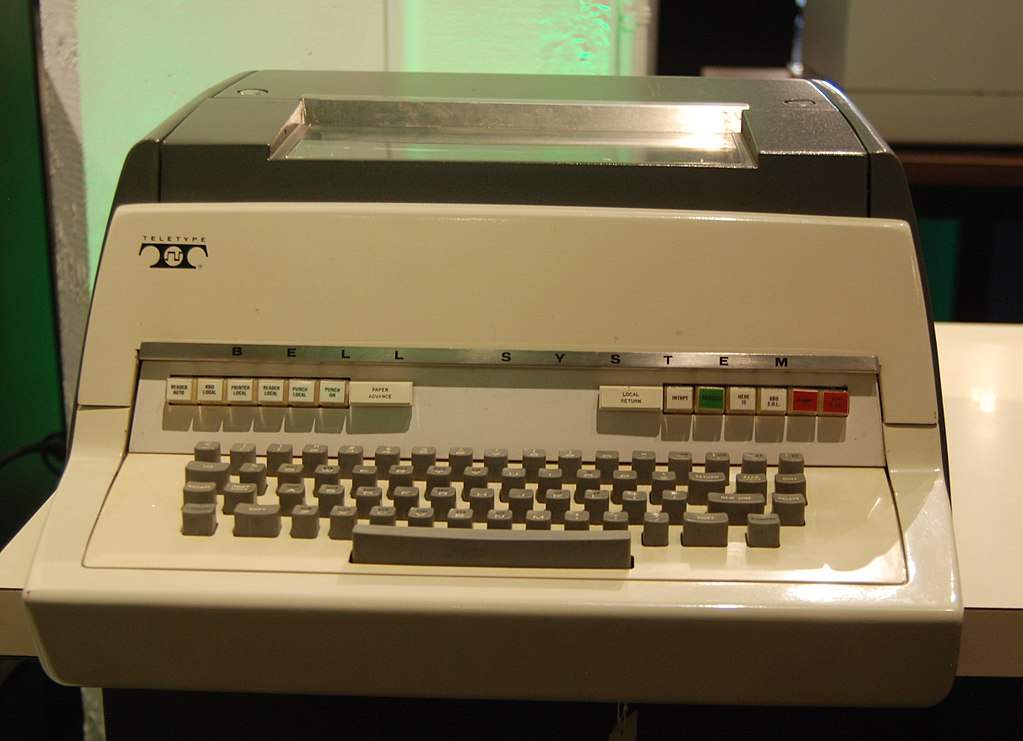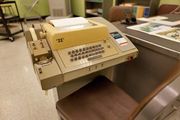Teletype Machines




In addition to sending and receiving text, Teletypes could also be used to transcribe text from keyboard to paper tape for storage and eventual re-use, and also to create line-printer carriage-control tape loops for printers such as the IBM 1403. In this case heavy-duty Mylar tape was often used instead of paper tape. At Columbia during the mainframe era, users could have operators "mount" custom printer control tapes for their jobs (see a story about this here).
Gallery
- Teleprinter, Wikipedia, accessed 25 March 2021.
- Teletype Model 33, Wikipedia, accessed 25 March 2021.
- Teletype Model 37, Wikipedia, accessed 25 March 2021.
- Carriage Control Tape, Wikipedia, accessed 25 March 2021.
- History of Teletypewriter Development, monograph, R.A. Nelson (K. M. Lovitt, Editor), Teletype Corporation, October 1963.
- A Synopsis of Teletype Corporation History, Don Robert House, 2001.
- The North American Data Communications Museum (NADCOMM)
- The Teletype Story (50th anniversary of the Teletype, 1957, commemoration booklet)
- Teletype Corp (photos and specs of many models).
- Morkum Model GPE Perferator ("Iron Horse")
- Nurturing the Network: Women and the Communications Industry (IEEE), includes a 1946 film clip of Teletype operation.
- Teletypesetter Gallery of Images, circuitousroot.com, accessed 25 March 2021 (PDP-8 with Teletype).
- An amusing Photo, Bell Labs, 1972: Ken Thompson and Dennis Ritchie, PDP-11/20, two ASR33s.
- Birth of an Internet Lo and Behold, Bradley Thornton, linboard.org, accessed 25 March 2021 (ttyasr33b.jpg)
-
Teletype ASR 33 , Computermuseum der Stuttgarter Informatik, uni-stuttgart.de, accessed 25 March 2021. - FAQ - Using a Teletype to Interface with a Computer, vintagecomputer.net, accessed 25 March 2021 (print ad).
- The Digital Equipment Corporation PDP-7, soemtron.org, accessed 25 March 2021 (pdp7).
- Benj Edwards, A brief history of computer displays, PC World, accessed 25 March 2021 (pdp7).
- PDP-12 Laboratory Instrument Computer User Handbook, Digital Equipment Corporation (1969), converted to HTML by Carl R. Friend, accessed 25 March 2021 (pdp7).
Translations of this page courtesy of...
| Language | Link | Date | Translator | Organization |
|---|---|---|---|---|
| Belarusian | Беларуская | 2023/08/21 | Vladyslav Byshuk | Владислав Бишук | studycrumb.com |
| Finnish | Suomi | 2023/08/31 | Kerstin Schmidt | writemyessay4me.org |
| French | Français | 2023/08/25 | Kerstin Schmidt | prothesiswriter.com |
| German | Deutsch | 2023/08/25 | Kerstin Schmidt | writemypaper4me.org |
| Italian | Italiano | 2023/08/31 | Kerstin Schmidt | admission-writer.com |
| Polish | Polski | 2023/08/25 | Kerstin Schmidt | justdomyhomework.com |
| Russian | Русский | 2023/08/21 | Vladyslav Byshuk | Владислав Бишук | studybounty.com |
| Spanish | Español | 2023/08/31 | Kerstin Schmidt | pro-academic-writers.com |
| Ukrainian | Українська | 2023/08/21 | Vladyslav Byshuk | Владислав Бишук | skyclinic.ua |











